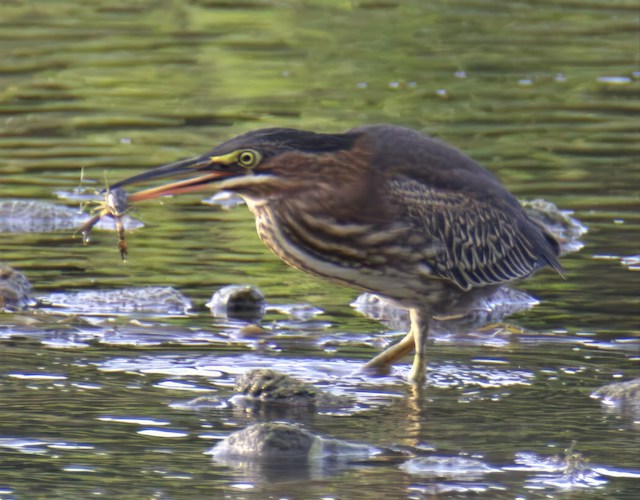I’ve always loved to come across a Green Heron when I’m on the river fishing or hiking in a riverside forest preserve. These interesting herons are less frequent sights than their larger cousins, the Great Blue Heron and the Great Egret in our area. These beautiful birds have been on the decline over the last fifty years across their range, unlike their larger cousins. They are not an endangered or threatened species on either the state or federal level because they have yet to meet the threshold to qualify for those designations. However, they are a species in steep decline (an over 50 percent decline in 50 years) that certainly deserves our special attention. In the past, these birds were hunted for food or because they were perceived as a threat to local fish populations. Today, the major threat to the Green Heron appears to be habitat loss as wetland areas are disappearing and being developed at unsustainable rates.
Meet the Green Heron
So seeing a Green Heron is becoming an increasingly rare treat. These small herons differ from the Great Blue Herons and Great Egrets, the other members of their family that commonly reside in the Fox River watershed, not only in their size, but also in their behaviors. The Green Heron is short and stocky in comparison to the Great Blue Heron and the Great Egret. It stands from 16 to 18 inches tall, weighing about a half-pound with an approximate two-foot wingspan. This compares to 38 to 54 inches tall for the Great Blue Heron and 37 to 41 inches tall for the Great Egret.
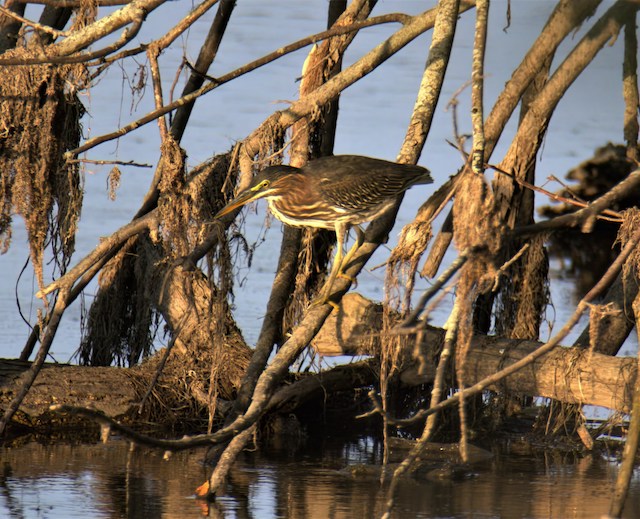
They have relatively short legs and necks when compared to their larger cousins and tend not to wade in the water when hunting like the Great Blue Herons and Great Egrets do. Rather, they stand on the shoreline or hunt from a solid surface like a branch that extends into the water waiting for their quarry to come to them. Like their cousins, though, their main prey is fish and crayfish which they catch with lightning quick strikes from their powerful, pointed bills.
While all three species stalk their prey, the Great Blue Heron and Great Egret tend to wade very slowly in deeper water, using their long legs to their advantage. They patiently stalk to within striking distance of an unlucky fish that falls prey to the fast strikes of their lethal bills powered by their exceptionally long necks.
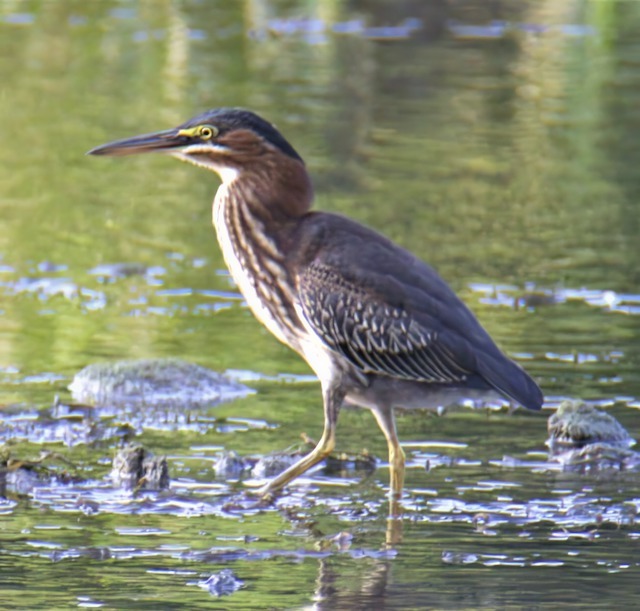
Smaller, Yet Mighty Clever!
The Green Heron, on the other hand, doesn’t have the long legs and long neck of the two larger birds and has adapted to use a different hunting strategy. They don’t often actively wade in search of their quarry and instead will stand motionless on the shore or on a branch that extends into the water and wait in ambush for a hapless fish to happen by. They strike their prey in the same manner, quickly thrusting out their bills with their shorter necks, and are very efficient at capturing the quick fish that they pursue. They just don’t have the same “strike radius” as their larger cousins and this fact has perhaps led some Green Herons to use a rather clever technique that seems to demonstrate a level of intelligence not commonly seen in the animal kingdom.
Some Green Herons have been observed to use “bait” to draw inquisitive fish within striking range! They have been seen to pick up feathers or small twigs that they toss into the water and wait for a small fish to come and investigate a possible food source, thus themselves becoming food for the Green Heron! These birds have also been known to steal pieces of bread* being used by people to feed ducks or fish to use for their bait!
In one account that I heard years ago, a university biologist in Minnesota and his wife and small child loved to walk on a path around a small lake near their home and would take pieces of bread to feed the ducks they’d encounter in the park along the lakeshore. One day, a Green Heron joined the ducks and picked up one of the small bread pieces and, instead of eating it, flew away with it across the lake. This happened on several walks in a row. The biologist closely watched the heron to see where it flew to, and he noticed that it always went to the same spot across the lake. He was curious to know what the heron was doing with the bread as he knew the bread wasn’t typically something a heron would eat.
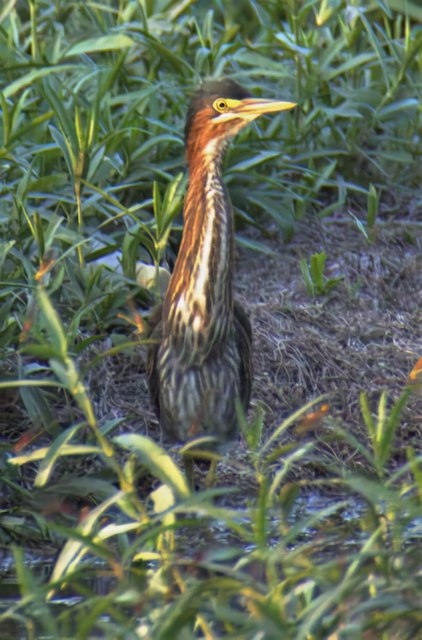
in Yorkville, Illinois.
He formulated a plan to find out what the heron was doing. He asked his wife to take their daughter on their normal walk and to feed the ducks as they normally did while he would set up a blind in the area across the lake and wait for the heron to fly in after picking up the bread. The plan worked perfectly as the bird took a piece of bread that the biologist’s wife and daughter threw for the ducks and headed straight toward the blind he had set up. Once there, the biologist watched in amazement as the heron walked to the water’s edge, cast the piece of bread out onto the water and waited, watching motionless from the shore. After a minute or two, small fish began to appear to feed on the piece of bread thrown by the heron. The heron tensed and struck with a lethal quickness, catching and consuming one of the little fish! The biologist was awestruck as he had witnessed this Green Heron execute an apparently thought-out plan to use the bread he had taken as bait to capture fish for his sustenance! This experiment was repeated over and over on subsequent occasions with the heron always being successful in his “fishing” outings using the bread as bait.
Since that time, many other observers have reported seeing Green Herons (along with a couple of other heron species including the Black-crowned Night Heron that also occurs in the Fox River watershed) actively using bread as bait to lure fish in. In fact, quite a few videos exist online that show these birds engaging in this activity!
Nature or Nurture?
The question becomes: Is this bait use instinctual behavior somehow hard-wired into the bird’s genetics, or is it a learned behavior? The jury is out on this so far and there is credible evidence supporting both the innate behavior and learned behavior hypotheses. It’s a fascinating phenomenon to consider! Do these birds have the higher-order cognitive skills that enable them to use tools (like the bread as bait) to solve a problem (catch a fish to get their lunch), or is this behavior simply the manifestation of instinctual behavior that has evolved over eons of evolution. If the birds do possess the higher-order thinking skills that help them solve problems (and there’s quite a bit of evidence to support the hypothesis that they do), and these birds have the capacity to learn from observing circumstances around them, then we might have to re-think the use of the pejorative term: “bird-brain!”
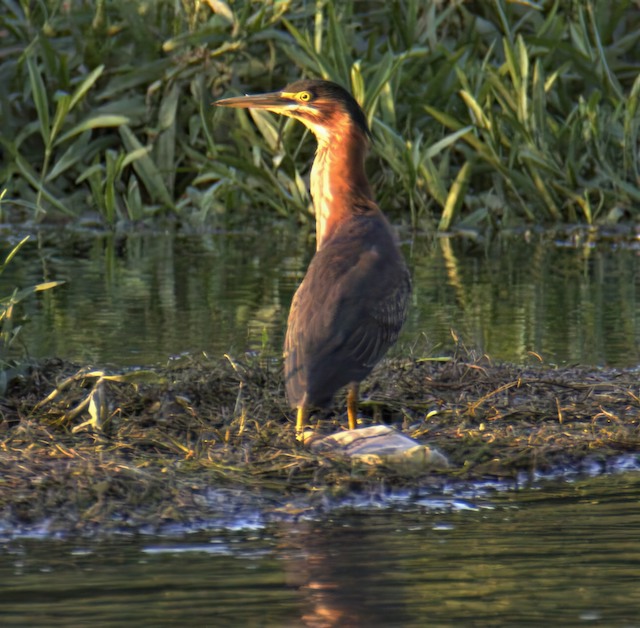
Apparently only a relatively small proportion of Green Herons use the baiting technique to help them catch fish. I have not personally witnessed any of them using the technique on the Fox River. I’m always hopeful that I might see them hunting this way someday, though! For the time being, I’m just grateful when I get to see and hear these beautiful birds in our wonderful Fox River watershed!
Until next time, keep enjoying the natural wonders of our beautiful watershed and Together We Keep On Fixing the Fox!
*Feeding bread to wildlife is not recommended. It has no nutritional value for them and can cause digestive problems.
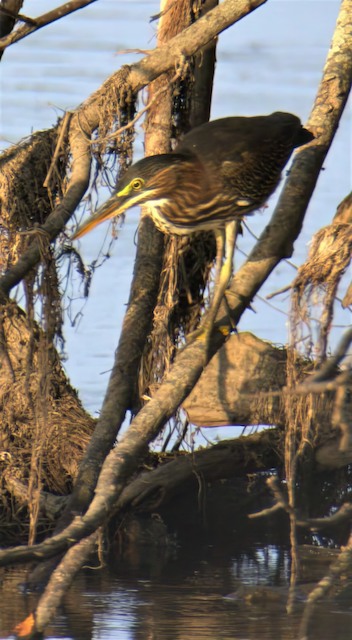
among the low branches overhanging the surface of the Fox River along the shores of
the Hoover Forest Preserve in Yorkville.

